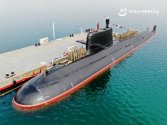In addition to what FairAndUnbiased said, the moment you introduce nuclear into the equation, your costs goes up multifold, so it doesn't make sense to have a nuclear power unit 10% the power of a classical SSN and expect to only have 10% of the purchase and 10% of the maintenance costs. Your 1-2 MW reactor will still require you to have highly skilled nuclear power engineers on the crew, nuclear fuel cycle procedures, radiation shielding, reactor management systems, isotopic gas and fusion byproduct management systems, etc. By that point you might as well go full SSN due to the sunk costs. This is also why small localized nuclear power plants have not taken off for land based utility power generation.
I think it might depend on how tech evolves. A thermal power plant running a coal fired steam turbine and a car are both fossil fuel fired, but the car is operable by 1 person while the coal fired steam turbine needs a team of full time engineers and technicians to keep running.
There are some modular reactors like pebble bed gas cooled types that are simpler, safer and less prone to failure than water cooled types, but have had limitations on maximum power generation relative to water cooled ones when staff is available.
They might use an upscaled version of this. Extremely safe, designed for deep space missions lasting decades with no maintenance. There's also plenty of mirco nuclear reactor designs floating around that require very maintenance and are designed to be mass produced to lower cost. Small too, they can be fitted to the back of a truck.
Size shouldn't be a issue. Switching from lead acid to lithium ion probably already provides a vast improvement in space, with lithium ion having around twice the volume and mass energy density. If you have a constant 1MW electrical output, you can further cut your battery size and diesel storage by a lot too.
Of course, all this changes and you might as well just design a new submarine from the ground up.


